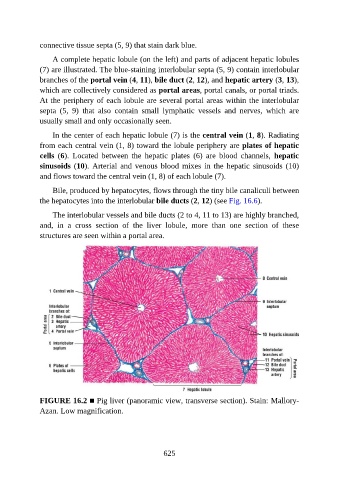Page 626 - Atlas of Histology with Functional Correlations
P. 626
connective tissue septa (5, 9) that stain dark blue.
A complete hepatic lobule (on the left) and parts of adjacent hepatic lobules
(7) are illustrated. The blue-staining interlobular septa (5, 9) contain interlobular
branches of the portal vein (4, 11), bile duct (2, 12), and hepatic artery (3, 13),
which are collectively considered as portal areas, portal canals, or portal triads.
At the periphery of each lobule are several portal areas within the interlobular
septa (5, 9) that also contain small lymphatic vessels and nerves, which are
usually small and only occasionally seen.
In the center of each hepatic lobule (7) is the central vein (1, 8). Radiating
from each central vein (1, 8) toward the lobule periphery are plates of hepatic
cells (6). Located between the hepatic plates (6) are blood channels, hepatic
sinusoids (10). Arterial and venous blood mixes in the hepatic sinusoids (10)
and flows toward the central vein (1, 8) of each lobule (7).
Bile, produced by hepatocytes, flows through the tiny bile canaliculi between
the hepatocytes into the interlobular bile ducts (2, 12) (see Fig. 16.6).
The interlobular vessels and bile ducts (2 to 4, 11 to 13) are highly branched,
and, in a cross section of the liver lobule, more than one section of these
structures are seen within a portal area.
FIGURE 16.2 ■ Pig liver (panoramic view, transverse section). Stain: Mallory-
Azan. Low magnification.
625

